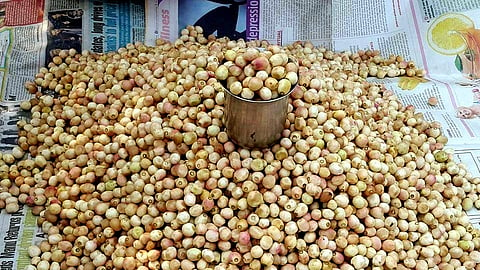

BY ASAVARI KULKARNI
It's summertime in Goa! It's the season of the scorching sun and sweating bodies. People often run to the hill stations or interior forested villages to beat the heat. However discomforting, the summer in Goa adds a lot of colour to the surroundings!
Also known as the season of spring, it brings cheer to Goa's forests, plateaus and hillsides that come alive with colourful flowers and juicy fruits -- many of these are endemic to the Western Ghats.
A walk into the wild and you will see multiple shades of colours that come alive only in April.
As you walk the trails, the surrounding flora will welcome you making you forget the humid discomfort of the summer. Picking up summer fruits in the forests is a habit Goans nurtured over the ages, but, in the age of social media and technology, this has taken a backseat.
TROPICAL GARDEN
Goa’s forests are a treasure trove of a variety of species of plants useful to humankind. We have nearly 1,750 species of recorded plant species. Out of this nearly 100 yield edible fruits and berries.
Goa was known as the tropical botanical garden at the end of the 18th century. All these plants added to the nutrition and health of Goan people.
SEASONS OF JOY
Talking about wild fruits, Goa has plentiful of these in all the seasons -- whether it is pouring rain, winter or scorching summer! However, the best time to enjoy seasonal fruits is March, April and May, the months of spring and summer.
Plucking wild fruits in the forests was a great pastime among the younger generation till the late 90s, but mobiles and laptops are weaning them away from this healthy habit.
ELDERS' WISDOM
Most of the fruit plants are thorny and grow among thick bushes or on big trees, making their harvesting difficult and challenging.
Young fruiting plants in particular develop thorns for protection from animals.
We always ventured inside the forests to pluck wild fruits with a mixed group of teenagers equipped with tips and tricks from our elders on how to bag these without getting scratches on the body.
STRAIGHT FROM THE PLANTS
There was no concept of washing the fruits once plucked and we consumed them straight from the plants. Our hands would be full of the sticky gum of kannas (berry-sized fruit).
Once we had our fill, the rest of the fruits were brought home in eco-friendly (that’s a fancy word nowadays) leaf cones made out of kumyo (careya arobrea) or chandivdo leaves (macaranga peltata). The leaf cones were stitched together using thorns of the kanna plant.
NATURAL VITAMINS
A trip to the jungle for the love of these wild berries gave us that joy that today's kids find on their laptops and mobile phones. The wild walk taught us useful navigation skills through the woods, and fresh air was another bonus.
Also, these fruits added those extra vitamins and minerals which today’s children take in the form of multivitamin tablets.
Right from the month of October, we saw the festival of fruits unfolding before us starting with kanera or tiny black jackal jujube (ziziphus oenoplia), followed by boram (ziziphus mauritiana) and then came pink cotton fruits or chunna (ziziphus rugosa), all three belonging to one botanical family.
WILD FRUITS GALORE
By the time we got bored of cotton fruits or chunnas, kannas (carrisa carandas) would be ready. Plucking kannas from the thorny shrubs would give us those scratchy designs on our hands.
Children living in villages are lucky to get access to some of these lesser-known fruits like bhedsa (syzigium sp.), dhaman (Grewia tiliifolia), chafra (flacortia montana), pitkulni (ixora coccinea), phather phod (bridelia sp), anjan (memecylon umbellatum), etc.
Children living in villages are lucky to get access to some of these lesser-known fruits like bhedsa (syzigium sp.), dhaman (Grewia tiliifolia), chafra (flacortia montana), pitkulni (ixora coccinea), phather phod (bridelia sp), anjan (memecylon umbellatum), etc.
MEDICINAL AND MAGICAL
Also, how can we forget the most favourite and medicinal, jamun or zamblam. Goa has more than 20 varieties of jamun. It is a wonder fruit and is in demand because of its properties that can cure diabetes. Modern pharmacological research has shown that jambul extract reduced tumour incidence, tumour burden and gastric carcinomas and was found effective in preventing benzo-a-pyrene-induced stomach carcinogenesis.
These wild fruits not only have medicinal properties, but the trees on which they grow, their barks, thorns, leaves etc have curative values as well.
SAVE THIS NATURE'S BOUNTY
All these fruits have flavonoids and antioxidants useful for our body. Boram and other ziziphus fruits like chunna and kanera are known to have properties that can cure liver diseases, muscular conditions and diabetes. Chafra or atka is used to treat fever as this is found to have anti-bacterial properties.
The diversity of these fruits is in danger due to increasing urbanisation. These wild bushes where the wild fruits are found are being slaughtered everywhere for development.
GANVTI BOTANICAL EXCURSIONS
We find these fruits sold in the markets by elderly village women who know their importance. If we want our children to enjoy these equally, we must protect them. How? We can dry the seeds, make them into small seed balls and while on our hillside trips spread them around.
This can be done before the onset of the monsoon season. Or you can even allot a plot in your backyard for these wild wonders to grow so that the summers are filled with these juicy treats forever.
Every time we ventured into Goa's wild, we came back curious to know about the fruit-bearing plants and always had questions for our elders, who enriched our ethnobotanical knowledge. As I look back, I am glad to say that those ganvti botanical excursions were all worth it.